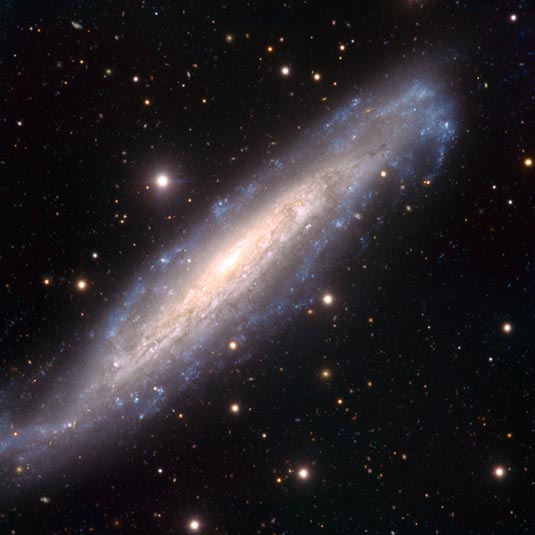
Spiral Galaxy
RA 3hr 44m 31.80s Dec -44° 38' 23.40"
Horologium
60 million light years
10.7
7.6' x 1.7'
6.80 x 6.69 arcminutes
North is 90.0° right of vertical
ESO
December 3, 2009
Closeup: G1711
ABOUT THIS IMAGE:
Portrayed in this beautiful image is the spiral galaxy NGC 1448, with a prominent disc of young and very bright stars surrounding its small, shining core. Located about 60 million light-years away from the Sun, this galaxy has recently been a prolific factory of supernovae, the dramatic explosions that mark the death of stars: after a first one observed in this galaxy in 1983, two more have been discovered during the past decade.
Visible as a red dot inside the disc, in the upper right part of the image, is the supernova observed in 2003 (SN 2003hn), whereas another one, detected in 2001 (SN 2001el), can be noticed as a tiny blue dot in the central part of the image, just below the galaxy's core. If captured at the peak of the explosion, a supernova might be as bright as the whole galaxy that hosts it.
NGC 1448, also listed as NGC 1457 is a spiral galaxy of type Sc and is located in the constellation of Horologium . The galaxy has an angular extent of 7.6' × 1.7' and an apparent magnitude of 10.7. It was discovered on October 24, 1835 by John Herschel.
This
image was obtained using the FORS instrument mounted on one of the 8.2-meter
telescopes of ESO's Very Large Telescope on top of Cerro Paranal, Chile.
It combines exposures taken through three filters (B, V, R) on several
occasions, between July 2002 and the end of November 2003. The field of
view is 7 arcminutes